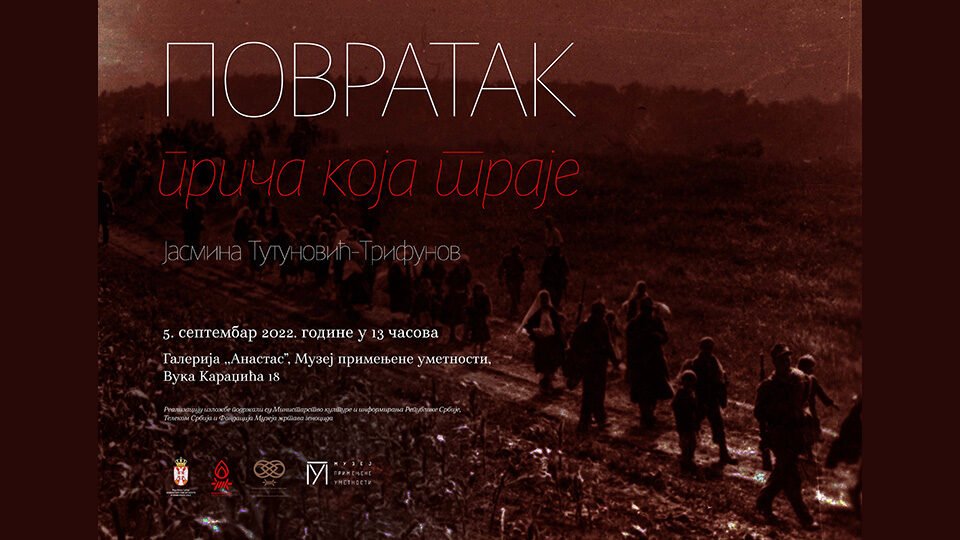RETURN: THE NEVER-ENDING STORY
Оrganizer: The Genocide Victims’ Museum, Belgrade
The author of the exhibition is Ms. Jasmina Tutunović-Trifunov, senior curator at the Genocide Victims’ Museum and head of the Group for preservation, access to archives, professional processing of archive materials and digitization.
The author of the installation is Mr. Nikola Radosavljević, Ph.D., Head of the Group for Programs in Culture, Education, Art and Publishing of the Genocide Victims Museum.
The Genocide Victims’ Museum is setting up a representative exhibition entitled “Return: The Never-Ending Story” on the occasion of commemorating the anniversary of the suffering of the civilians, especially children, during the Second World War on the territory of occupied Yugoslavia, as well as the 80th anniversary of the German-Croatian offensive in the Kozara region in the summer of 1942.
RETURN: THE NEVER-ENDING STORY
The end of the Second World War and the armed conflicts in Yugoslavia opened many questions concerning the position of children in the new political and social order, especially the position of war orphans.
During the existence of the Independent State of Croatia, children shared the fate of their families and died in individual and mass murders, in refugee camps, in numerous death camps. From October 1941, through the action of Diana Budisavljević and other humane people, several thousands of Serbian children were rescued from the Jasenovac camps. Since the summer of year 1942, those children have been placed in shelters, hospitals and other institutions, or were adopted by foster families. In May 1945, when the new communist authorities took away the various records created by Diana Budisavljević and her associates about the taken children, the youngest were deprived of the right to know their identity and the possibility to return to their families after the final and complete liberation of the country. Meanwhile, many parents never learned the fate of their children, lost forever in the war.
With the ending of the war, announcements were often published in the Yugoslav press, such are: “I am looking for someone of my own”, “I think I am from Kozara”, “The trail was lost before Jasenovac”, “Maybe a stranger saved little Zora”, “Mother Draginja is still waiting for her sons”.
Good few of children found their way to ancestral homes thanks to the dedicated work of a few, such were Marin Zurl or Dragoje Lukić. Marin Zurl was a journalist of the Zagreb’s weekly Arena, who launched in 1963. the campaign entitled: “Arena is looking for your loved ones”. Many collaborators such as Dragoje Lukić supported him. Dragoje Lukić himself is well-known for decades of investigation of the suffering of the children in the Independent State of Croatia.
Through their efforts, and at the request of the author, sculptor Tonet Svetina, the “Wounded Bird” monument has been erected in Gornji Podgradci. Made of trophy weapons, in the shape of a bird with a broken left wing, they dedicated the monument to all the children who did not return home from the war.
The exhibition entitled “Return: The Never-Ending Story” talks about the continuous hope and perseverance of the surviving children. Those children are grown-up people today and they have not stopped believing that they will find out who they are, who their parents are and what happened to their family members during World War II, or where they came from, even after eight decades since the great epic of Kozara in 1942.
ABOUT AUTHOR
She is the author of several professional and scientific works, of which the monographic publication “Campers: memorials” was especially significant, as well as: “Sixty years of preserving the memory of the crimes of genocide committed in the Independent State of Croatia during the Second World War” (co-authors Milinko Čekić and Nenad Antonijević) and the historiography study “Action Diana Budisavljević (1941-1945)”.
Her particular area of interest is the history of the 20th century, the position and suffering of the civilian population, primarily children in war conflicts, pedagogical and methodological topics of history teaching, as well as the application of modern trends in museology and archival science.



